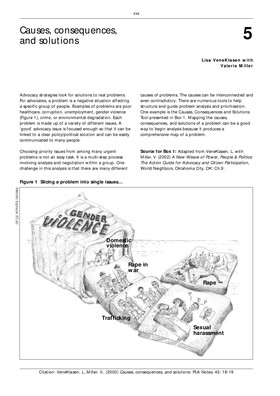Causes, consequences, and solutions (PLA 43)

Advocacy strategies look for solutions to real problems. For advocates, a problem is a negative situation affecting a specific group of people. Examples of problems are poor healthcare, corruption, unemployment, gender violence (Figure 1), crime, or environmental degradation. Each problem is made up of a variety of different issues. A ‘good’ advocacy issue is focused enough so that it can be linked to a clear policy/political solution and can be easily communicated to many people. In many cases identified problems, like corruption or crime, can take on a number of different forms and can be attributed to a number of different causes. This paper introduces a tool that helps map the causes, consequences and solutions to a problem, so it can be tackled more effectively.
This article was published in PLA 43: Advocacy and Citizen Participation. Participatory Learning and Action (PLA, formerly PLA Notes) is the world's leading series on participatory learning and action approaches and methods. PLA publishes articles on participation aimed at practitioners, researchers, academics, students and activists. All articles are peer-reviewed by an international editorial board.
This article was published in PLA 43: Advocacy and Citizen Participation (February 2002).
Cite this publication
Available at https://www.iied.org/g01977